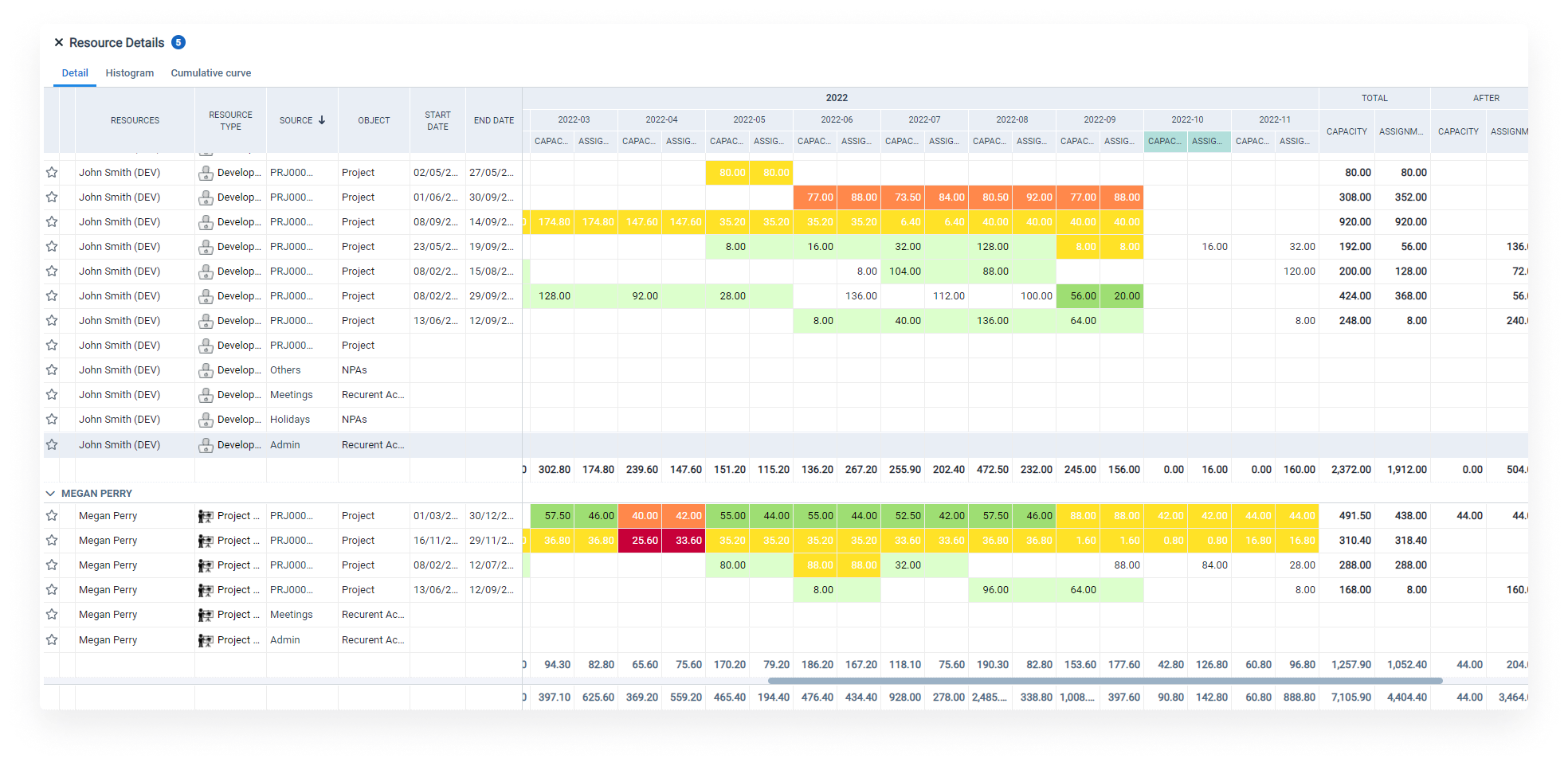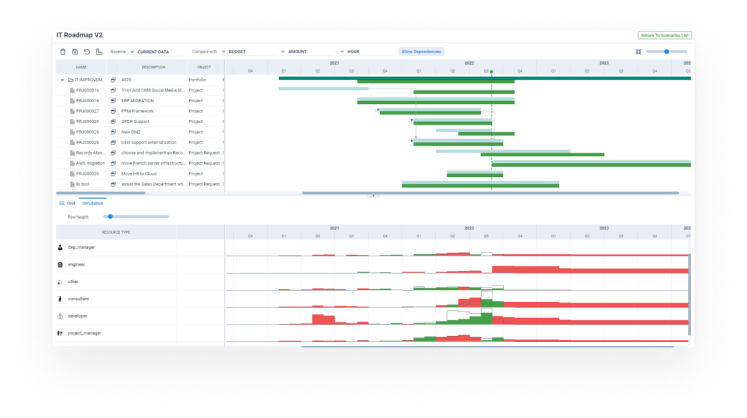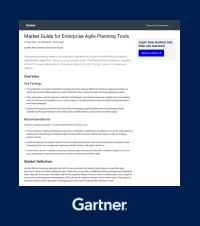How to manage resource constraints in a multi-portfolio environment

In today’s business landscape, with more and more corporations operating globally, many have had to expand their project and product portfolios to remain competitive in their markets. Multi-project management and interdependencies between projects have become the norm. And although it is an approach that, when well executed, ensures productivity and outcomes, it is not without its challenges. And the most common one is resource constraints.
In this article we will discuss how to manage resource constraints in business environments with diverse project portfolios. In addition, we will help you optimize your Resource Management strategies to achieve your strategic objectives with a series of best practices for your PMO to implement now.
Resource constraints: a brief definition
The management of resource constraints is understood as a series of limitations that organizations face to successfully execute their projects. These limitations are usually related to the availability of time, money and personnel to efficiently execute project portfolios.
In multi-portfolio environments, these constraints are often very complex and interrelated. Therefore, it is important to understand them thoroughly so that they don’t have a negative impact on scope, schedules, and overall project success.
Resource constraints are often very complex and interrelated
Examples of resource constraints
Resource constraints may vary by industry, company and project type. However, there are some types of resource constraints that are common in a variety of contexts.
1. Time constraints
Time constraints are one of the most common and relentless challenges in project portfolio management. As companies have to manage a larger number of portfolios, time constraints can cause delays and bottlenecks, jeopardizing overall strategic objectives.
These time constraints can arise due to a variety of factors:
- Competing deadlines: when projects in different portfolios have overlapping deadlines, it is difficult to allocate resources and manage workloads efficiently.
- Staff availability: limited availability of qualified personnel can create time constraints, making it necessary to plan work based on the availability of resources rather than project priority.
- Project dependencies: dependencies between projects can have a devastating domino effect when delays occur in one of them.
In a multi-portfolio environment, delaying a single project can lead to risks associated with cost, customer satisfaction or lost business opportunities. That’s why it’s crucial that you assess and address time constraints early on so that you can develop effective strategies to overcome them successfully.
Project delays can lead to risks associated with cost and customer satisfaction
2. Cost constraints
Balancing costs and allocating funds efficiently when you have tens or even hundreds of initiatives to manage in your portfolio can be overwhelming. Managing budget constraints requires careful planning, proactive monitoring of project costs, and effective financial controls.
Cost constraints can be caused by a wide variety of factors:
- Limited budget: you may have a fixed budget assigned to each project portfolio in your organization, which makes it difficult to meet the financial requirements of all projects.
- Changes in scope: extending the scope of a project may entail additional costs, causing the budget allocated to the project to be exceeded.
- Market conditions: changing market conditions (political or financial instability, entry of new competitors or new products in the market, etc.) may result in cost overruns.
Efficient management of cost constraints requires proactive identification of potential cost overruns so that effective measures can be taken to mitigate them. These measures may include:
- Control and monitor project expenses.
- Identify savings opportunities.
- Negotiate better prices with suppliers.
- Etc.
3. Scope constraints
As companies’ project portfolios expand, tough decisions must be made as to what to include or exclude from the initial project planning. As projects progress, there are several factors that can cause the scope of projects to change. These are the most frequent:
- Changes in priorities: as strategic objectives change, project prioritization may be affected, which may affect the scope of projects that are already underway.
- Limited resources: Having a limited budget or staff can have a negative impact on the scope of the project. You may have to reduce the scope and scale of the project to fit the resources you have available.
- Competing stakeholder interests: having several project portfolios in a company can lead to conflicts of interest with different stakeholders in the organization, which can lead to disagreements and limitations on the scope of projects.
Budget or staffing constraints can negatively impact the scope of projects
4. Quality constraints
Maintaining high quality standards when managing multiple project portfolios can be challenging, especially when resources are limited. Ensuring quality is crucial to the success and reputation of any project, as it has a direct impact on customer satisfaction and the overall performance of the final product or service.
However, all the resource constraints mentioned above have a very negative impact on the final quality of the projects. For example:
- Lack of resources can hinder your organization’s ability to maintain consistent quality across all projects.
- Having tight deadlines can also compromise your quality, leading to errors and rework of completed tasks.
- Changes in project scope can negatively impact project quality, especially if these changes are not managed effectively.
The importance of linking resource management with strategic goals
As you can see, having limited resources is a very common issue in Project Portfolio Management, regardless of the sector in which your company operates. To manage this challenge, efficient Resource Management strategies must be put in place to help address them successfully and ensure proper project performance.
However, in order to achieve efficient Resource Management, it is necessary to provide a strategic approach to this process. And not only to successfully address the challenges related to resource constraints, but also to align your organization’s efforts with strategic objectives.
Resource Management processes must have a strategic approach
When managing multiple project portfolios, aligning resource management with strategic planning is key for the following reasons:
- Resource usage optimization: you will allocate resources to those projects that add the most value to the company’s long-term mission.
- Risk mitigation: by linking resource management to strategic goals, you will be able to identify in advance resource constraints and other potential threats that may hinder the achievement of these goals.
- Transparency and accountability: since the allocation of resources will be based on their potential impact on strategic results, the process will now be more transparent, and the efficiency of the process will be measurable.
Best practices to Identify and manage Resource Constraints
The benefits of linking resource management to strategic goals are clear. But, for efficient Project Portfolio Management, a number of practices must be employed to effectively circumvent resource constraints. Here are some key strategies:
1. Project prioritization criteria
Not all projects are the same. Therefore, the first step you should take is to establish clear criteria for prioritizing projects, so that resources are allocated to those that will add the most value to the business.
Some criteria you can establish when prioritizing projects are as follows:
- Strategy alignment: those projects that contribute most directly to the achievement of the strategic objectives should be given the highest priority.
- Cost-benefit analysis: depending on the potential ROI and expected benefits (both financial and non-financial), some initiatives will be prioritized over others.
- Risk assessment: projects with a higher risk profile may require more resources or closer monitoring.
- Resource availability: if there is a high demand for certain resources, priority should be given to projects that need them.
2. Perform a capacity planning assessment
It is essential to know and plan the resource capacity of your organization. Therefore, you should conduct a thorough assessment to help you determine how much demand can be managed within your resource constraints, so that you can plan and allocate resources more efficiently.
To assess capacity planning, you should follow these steps:
- First, create a detailed inventory of all your organization’s resources.
- Next, assess the skills and experience of your teams. Identify areas where additional training or external support may be needed to meet project demands.
- Then, analyze the efficiency level with which resources are used. You must identify underutilized resources that are overexploited in order to balance their use according to project priorities.
- Get a complete view of the resource demands for each project, program or portfolio.
- In parallel, you can simulate different resource allocation scenarios based on changing business priorities.
- And finally, you must establish mechanisms to track capacity and resource usage to avoid blockages and bottlenecks resulting from over-allocation or lack of resources.
3. Strategic resource allocation
Allocate resources strategically to ensure that each project portfolio receives the right amount of resources for its importance and objectives. This may require reallocating resources as business priorities change or new opportunities arise.
Some considerations to keep in mind when allocating resources:
- Allocate resources to those portfolios and initiatives that are aligned with your strategic objectives to maximize their impact.
- Resource allocation must be agile as project priorities and business objectives evolve.
- Avoid resource over-allocation, as this can lead to team burnout and decreased productivity.
- Periodically review your Resource Management strategy so that it is always aligned with the mission and vision of the business.
4. Agile project planning
As the number of projects in an organization increases, the more complex project planning becomes. You should therefore streamline project planning to reduce the risk of resource overload and potential bottlenecks.
Here are some tips we give you to speed up project planning.
- Make your company invest in a Project Portfolio Management software with Resource Management capabilities to have full visibility of all projects and resources.
- Develop standardized project planning templates and processes to streamline planning and reduce errors and misunderstandings.
- Anticipate potential risks and include risk mitigation strategies in your project plans to avoid resource constraints.
5. Continuous improvement
Resource constraints will always be there in one form or another. Sometimes it will be a lack of personnel, sometimes it will be a lack of budgets…. It is a challenge that evolves and takes many forms over time. You must therefore monitor your resource management strategies and adapt them according to the needs of the organization.
In a multi-portfolio environment, continuous improvement processes are more necessary than ever due to the dynamic nature of projects and resources. To promote continuous improvement in your organization you must:
- Establish performance metrics to evaluate the effectiveness of your Resource Management processes and identify areas for improvement.
- Conduct post-project reviews to identify lessons learned and best practices to be applied in future projects.
- Create mechanisms whereby team members can provide feedback and suggestions for improvement regarding resource allocation and project planning.
- Be prepared to adjust your resource allocation processes as new project data or changes in strategic objectives emerge.
Conclusion
Resource constraints are a reality that must be managed effectively. By understanding the types of constraints you may face, linking resource management to strategic objectives and applying best practices, you can optimize your project management efforts and achieve success.
Remember that resource constraints are not obstacles, but challenges that, with the right strategies and tools, can be addressed. And, for efficient, real-time management of project portfolios and resources, a PPM platform like Triskell Software’s is the best choice.
With Triskell’s Resource Management capabilities you can align capacity with incoming demand. Moreover, you will be able to allocate resources to those initiatives that will bring more value to the business in a flexible and intuitive way. In short, with Triskell you will quickly identify resource constraints thanks to its resource and capacity management features.
Request a demo of Triskell Software
Triskell meets all the requirements for your organization’s PMO to take a step forward in aligning your project portfolio with strategic planning.

Related Content

Why the CIO needs a PMO approach
Unlock business success: discover why the CIO must embrace a PMO approach! to elevate efficiency and boost productivity.

Lean Budgeting for Agile Portfolios: A Comprehensive Guide
Lean Budgeting: the financial revolution for Agile portfolios. Discover how to streamline project financing and optimize value delivery.

Implementing SAFe with a 7-step roadmap
Do you want to scale Agile at the enterprise level and don’t know where to start? We solve your doubts by explaining the steps to implement SAFe.



